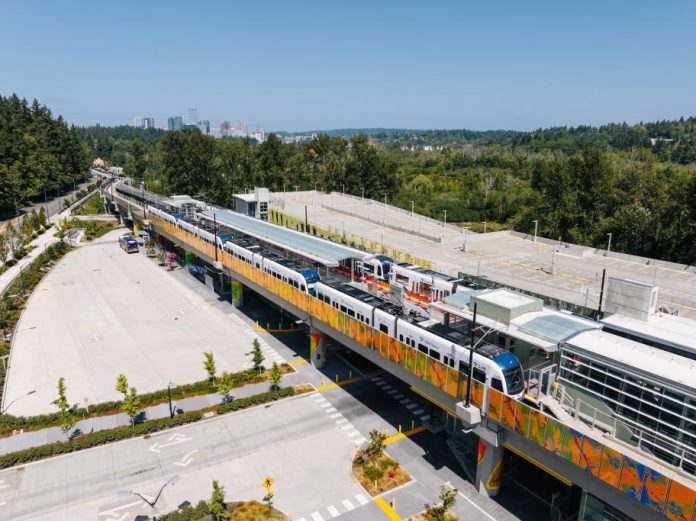The Eastside starter line received the go ahead from the Sound Transit Board of Directors on Thursday, which clears the way for the eastern portion of the East Link light rail, or the 2 Line, to open in spring 2024. At the monthly meeting, the board also approved $122 million in additional studies for the Ballard Link extension, which some transit advocates, including advocacy group Seattle Subway, argued were of dubious value and should be rejected.
Thus East Link’s timeline has moved forward while Ballard Link is slowed and in limbo with additional study. The extra work would allow the board to take the next step of advancing its new preferred alternative of skipping Chinatown and Midtown and shifting Denny Station’s location to the north into the final environmental study for the project.
Full East Link opening expected in 2025
Starter line approval was expected, as Ryan Packer noted in The Urbanist preview of the vote, but it ended up being unanimous among the 13 boardmembers in attendance. Assurances in the final resolution that the agency would do everything in its power to prevent the starter line from delaying Lynnwood Link or impeding 1 Line operations may have been enough to win over skeptical boardmembers from the north.
During starter line operations, Sound Transit plans to run the 2 Line with two-car trains every 10 minutes, 16 hours a day. The final service level will be approved by the Sound Transit Board as part of the 2024 Service Plan, which is expected in October. The agency projects the starter line will attract 6,000 daily boardings. East Link ridership projections jump to 43,000 to 52,000 daily riders by 2026, when the 2 Line should run from Lynnwood to downtown Redmond via downtown Seattle.
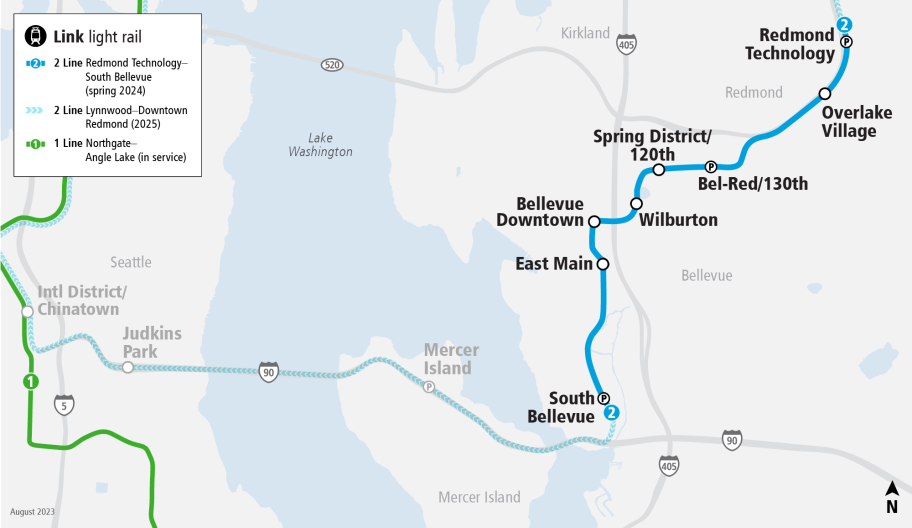
As the Sound Transit Boardmember to first propose the idea, King County Council Member Claudia Balducci took a victory lap upon passage.
“Almost exactly one year ago, when we first learned that Eastlink light rail would be significantly delayed due to workmanship issues on the I-90 bridge, I proposed that we open an Eastside-only starter line. Today, I was pleased that the Board unanimously decided to approve this plan,” Balducci said in a statement. “This pivot from a long-established plan to adapt to changing circumstances is a testament to hard work, creativity and nimble action by agency staff, as well as the overwhelming enthusiasm by cities and community members from across the Eastside who know how transformational these generational transit opportunities will be and how important it is to open them ASAP.”
Urbanist contributors Kelli Refer and Christopher Randels were also early backers of the Eastside starter line and made the case in an Urbanist op-ed. Refer also lobbied for the starter line as executive director of Move Redmond, which celebrated the vote Thursday.
It’s official! The East Link Starter Line has officially been approved by the Sound Transit Board! Thank you to everyone who has previously taken action & has showed support to make this happen!! 🎉👏🏽 pic.twitter.com/2VieG5KTSu
— Move Redmond (@MoveRedmond) August 24, 2023
Sound Transit CEO Julie Timm was an early adopter of the starter line idea, as well, although she warned of the many hurdles that needed to be cleared to make it happen. On Thursday, she thanked her team for navigating that work.
“This incredible accomplishment required significant commitment and collaboration across the entire Sound Transit Team, with King County Metro who hires for and operates our service, and by our federal, state, and local partners for every required review and approval,” Timm said in a statement. “It was seriously hard work to assess and then remove the barriers to accelerate opening of light rail on the Eastside by spring 2024, and there were many moments where it looked like this would be an impossible task in the time available to us. I am proud of the team’s unwavering dedication as Sound Transit continues to make history with the opening of each extension connecting the region through the largest transit expansion program in the country.”
Repairs to defective plinths along I-90, particularly on the floating bridge over Lake Washington, will allow 2 Line to stretch all the way from Redmond to Downtown Seattle and on to Lynnwood, as the Lynnwood Link extension is projected to open in fall 2024.
“It’s an exciting step to connect more communities via fast, carbon-free Link light rail, and opening these stations on the Eastside is the opening act of the 2 Line,” said Sound Transit Board Chair and King County Executive Dow Constantine. “From Redmond to Bellevue, people have a new option to get to work, school, and all the things that make this community special, and I’m excited to see what’s next when the 2 Line crosses Lake Washington in 2025.”
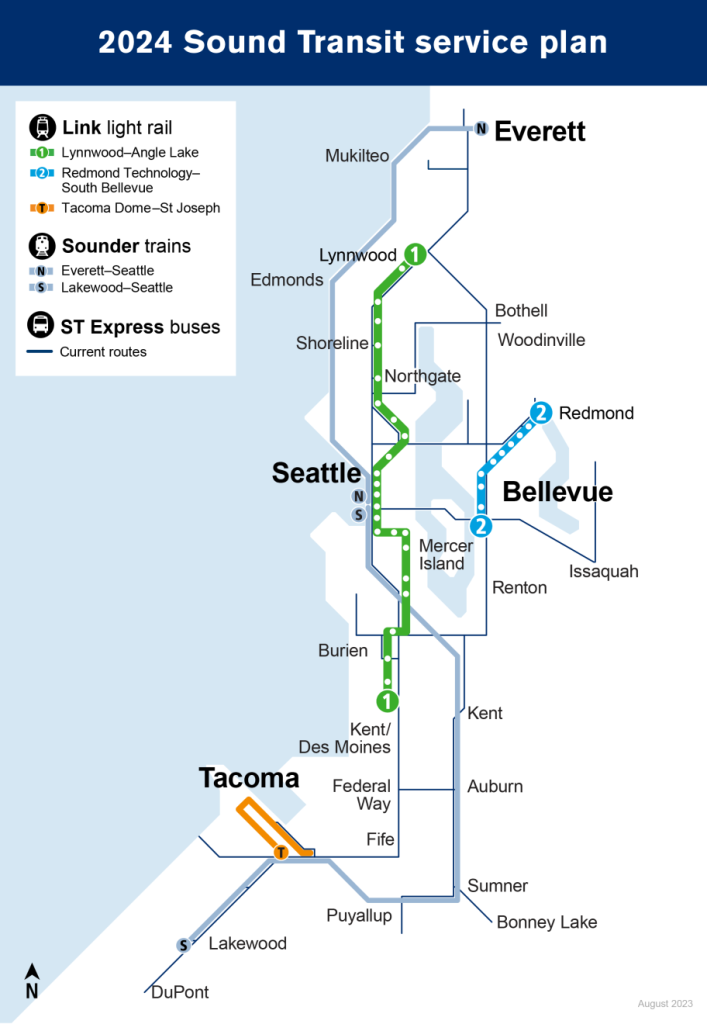
Voters approved East Link in 2008 as part of the Sound Transit 2 (ST2) ballot measure, while the extension to downtown Redmond was approved in 2016 with the Sound Transit 3 (ST3) measure. East Link construction began in 2017, including sequential excavation mining of the one-half-mile Bellevue tunnel, which was completed in 2020, an agency release noted. “Light rail test trains have been operating across the alignment to test the overhead electrical power system and train signal system, and simulated service is expected to begin in early 2024.”
With the vote Thursday, the Sound Transit Board authorized up to $43 million from the existing East Link $3.68 billion budget to fund the activities necessary to open the East Link Starter Line in spring 2024.
Ballard Link roiled in costly studies and indecision
Seattle Subway and Transit Equity For All lobbied for Sound Transit to reject additional studies that would delay Ballard Link and advance an alternative skipping Chinatown. The groups turned out a sea of red, with people waving red signs and submitting public comments, at Thursday’s meeting, but their plea was ignored.
Balducci acknowledged the swell of public sentiment but said the “only way out is through” the path of additional study.
That additional study is needed to develop conceptual engineering for late-emerging alternatives for the line and amend the Draft Environmental Impact Statement (EIS) to include them. Those options were added to the study after the initial draft in hopes of addressing neighborhood pushback at expected construction impacts coming from the Chinatown-International District (CID), Denny Triangle, South Lake Union, and Uptown neighborhoods.
The new options include the North and South of CID alternatives, which would mean abandoning stations planned at Midtown and Chinatown, two new stations for Denny Station, one new location for South Lake Union, and one new location for Uptown. The impetus for all of these additions is decreasing construction impacts rather than improving service for transit riders.
The pushback that boardmembers appeared to hear loudest of all came from Amazon, the largest private sector employer in the city, and Vulcan Real Estate, the largest developer and landholder in South Lake Union. Amazon and Vulcan were adamantly against the previous Denny and Westlake station option because Sound Transit said it would require a full closure of Westlake Avenue projected to last four years in early plans.
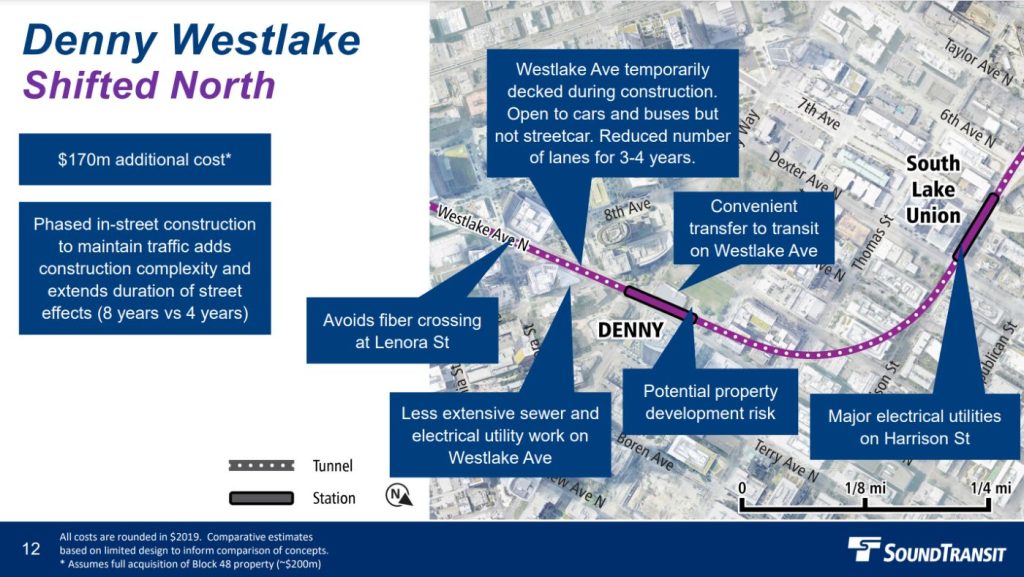
Channeling those concerns, Chair Constantine asked agency staff to confirm that the Shifted North for Denny Station would avoid a full closure of Westlake Avenue, which he received.
“And there would be at least one lane each direction available during that time? My request is that the staff sooner than is required by federal environmental studies come back with the traffic plan to help us understand to what extent we’re able to minimize or eliminate the inconveniences for residents and businesses in the South Lake Union area,” Constantine said. “Whether that involves improvements to allow additional traffic flow or signalization or other measures. I think that the board would like to know what exactly those impacts would be and what we can do affirmatively to reduce them. Is that something that staff can take on?”
As The Urbanist detailed Monday, Westlake Avenue carried only 9,100 average daily vehicles just south of Denny Way according to the most recent traffic count, which is from 2018 (before transit-only lanes went in). Those traffic counts plunge to just 4,500 one block south after the intersection with 9th Avenue and Blanchard Street. In other words, the $170 million extra cost for station alternative north of Denny Way would entail a subsidy of more than $37,000 per driver. Westlake just isn’t that central of a traffic artery, and mitigating construction impacts to it wouldn’t come cheap.
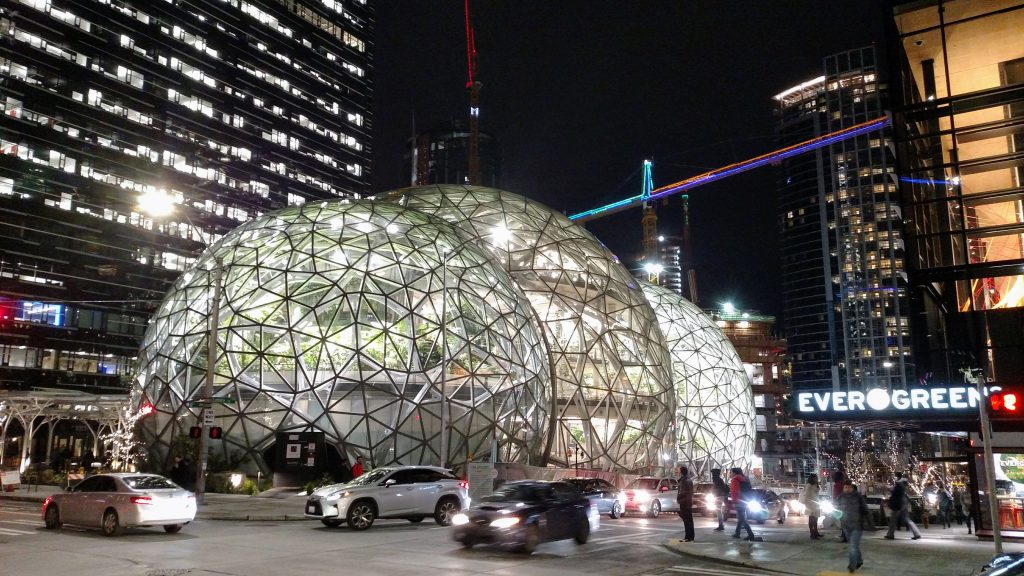
For now, the Shifted North Denny Station is the board’s preferred alternative after a tumultuous month when Seattle Mayor Bruce Harrell backed three different station options. First, Harrell appeared to endorse a Shifted West alternative that would drop the neighboring South Lake Union (SLU) Station. Then, he briefly backed the original Westlake location again to save the SLU Station, before ultimately landing on the Shifted North alternative.
Funding the alternative could be a sticking point, however, as Harrell stopped short of pledging the City of Seattle coffers to cover the estimated $170 million in added costs. And some boardmembers like Snohomish County Executive Dave Somers still appear to favor Shifted West and consolidating the two stations into one in order to cut costs.
The additional studies themselves come with cost. Including West Seattle Link “preliminary engineering” costs, the motion actually approves up to $146.8 million in additional payments to HNTB, Sound Transit’s contractor on the engineering and design work for Ballard and West Seattle Link. Of that, $122 million is for Ballard Link, but agency staff have argued most of that money would have been spent anyway on Final EIS work and engineering.
Still, Sound Transit staff attribute $32.8 million in added costs to studying the late additions and completing the second Draft EIS. And of the remaining $89 million in preliminary engineering and Final EIS work approved for the rest of Ballard Link, it appears a significant portion would also be for late additions, since nearly half the line (4 of 10 stations) is now composed of stations added after the original Draft EIS was completed and starting from nearly zero in terms of engineering work. Plus, delaying the project almost surely means it will be more expensive to build once it finally is shovel-ready due to inflation in both financing and construction costs.
The extra studies might illuminate a path forward or at least eliminate some options. Or it could be the board is left with the same tough choices and unfortunate tradeoffs they face right now.
Clarification: A Sound Transit spokesperson argued only the $32.8 million approved in Resolution No. R2023-25 should constitute costs attributed to the late-add Ballard Link alternatives, but the associated Motion M2023-69 does approve up to $122 million in additional payments to HNTB for “preliminary engineering” for Ballard Link. We’re seeking clarity on what those added costs are from besides the new alternatives not in the original Draft EIS. The piece was updated to reflect that ambiguity.
Doug Trumm is publisher of The Urbanist. An Urbanist writer since 2015, he dreams of pedestrian streets, bus lanes, and a mass-timber building spree to end our housing crisis. He graduated from the Evans School of Public Policy and Governance at the University of Washington in 2019. He lives in Seattle's Fremont neighborhood and loves to explore the city by foot and by bike.

